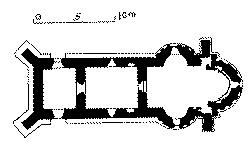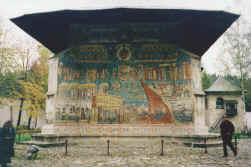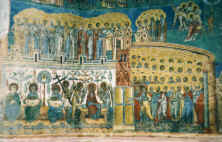 Voroneţ
Voroneţ| Home | Humor | Moldoviţa | Arbore | Voroneţ | Suceviţa |
| Link | Pictures | Pictures | Pictures | Pictures | Pictures |
 Voroneţ
VoroneţThe
church of St. George at Voroneţ, nestling among pine
trees ten kilometers to the east of Humor, is older, dating from 1488. Strong buttresses
at each corner ground the church to the earth, while its wide roof and spire give it a
light winged feeling. It was erected in three months and three weeks by Stephen the Great
after his third defeat of the Turks in 1486, to fulfill a pledge made to a hermit, Daniel,
who had encouraged him to fight. The church was built on the spot of Daniel's wooden
hermitage, and he is buried in it. Voroneţ was therefore a votive church, not a
monastery, and so had only a naos and nave.
 The interior frescoes date from the
time of Stephen's foundation. Between 1547 and 1550 Petru
Rareş had an enclosed porch added, creating side entrances, each surmounted by a
Gothic window, and ordered the external frescoes painted by anonymous monks. Because of
this late date, the siege of Constantinople is not pictured: the Turks had established
control over central Europe, and naturally took a dim view of such flagrant propaganda.
The interior frescoes date from the
time of Stephen's foundation. Between 1547 and 1550 Petru
Rareş had an enclosed porch added, creating side entrances, each surmounted by a
Gothic window, and ordered the external frescoes painted by anonymous monks. Because of
this late date, the siege of Constantinople is not pictured: the Turks had established
control over central Europe, and naturally took a dim view of such flagrant propaganda.
 The
church strikes by its blue coloration, due to the use of lapis lazuli. The paintings on
the north and, to a lesser extent, the west sides of the church have suffered damage, but
those on the south and west wall are beautifully preserved. The Tree of Jesse is a
harmonious composition in which white scrolls and details stand out against the blue
background and red-toned figures. The door is surrounded by scenes from the lives of St
Nicholas and St John.
The
church strikes by its blue coloration, due to the use of lapis lazuli. The paintings on
the north and, to a lesser extent, the west sides of the church have suffered damage, but
those on the south and west wall are beautifully preserved. The Tree of Jesse is a
harmonious composition in which white scrolls and details stand out against the blue
background and red-toned figures. The door is surrounded by scenes from the lives of St
Nicholas and St John.
 The enclosed porch
leaves an unbroken surface on the west for a magnificent Last Judgment, probably
the greatest of all those depicted on the painted monasteries. Angels sound the bucium,
the Romanian shepherds' instrument similar to the alpenhorn, as the graves give up the
dead and wild animals come bearing the limbs they have devoured. An elephant ambles along,
King David is shown playing the Moldavian cobza (a kind of guitar or lute), and the
Siren who seems to depict the sea rides her dolphin. In a medallion above them sits Christ
in glory, while below him is the throne of judgment, adorned with the cross and bearing
the Gospel and the dove that symbolizes the Holy Spirit. The hand of God below holds the
scales that weighs the souls of men.
The enclosed porch
leaves an unbroken surface on the west for a magnificent Last Judgment, probably
the greatest of all those depicted on the painted monasteries. Angels sound the bucium,
the Romanian shepherds' instrument similar to the alpenhorn, as the graves give up the
dead and wild animals come bearing the limbs they have devoured. An elephant ambles along,
King David is shown playing the Moldavian cobza (a kind of guitar or lute), and the
Siren who seems to depict the sea rides her dolphin. In a medallion above them sits Christ
in glory, while below him is the throne of judgment, adorned with the cross and bearing
the Gospel and the dove that symbolizes the Holy Spirit. The hand of God below holds the
scales that weighs the souls of men.  Devils try to bring down one side, while angels fight
them off with lances. To the right, evildoers (depicted as contemporary kings and popes,
Jews, Turks, and Tatars) await divine judgment, and a river of fire bears sinners to
eternal torment. At the bottom, St. Peter leads the elect, opening the doors to
Paradise, identified by a light background with stylized plants, where patriarchs Abraham,
Isaac and Jacob (the latter two holding on their laps the souls of the righteous, depicted
as swaddled infants), St. John the Baptist, and two angels attend theVirgin. On the
northern wall are shown scenes from the creation of the world and the life of Adam and
Eve.
Devils try to bring down one side, while angels fight
them off with lances. To the right, evildoers (depicted as contemporary kings and popes,
Jews, Turks, and Tatars) await divine judgment, and a river of fire bears sinners to
eternal torment. At the bottom, St. Peter leads the elect, opening the doors to
Paradise, identified by a light background with stylized plants, where patriarchs Abraham,
Isaac and Jacob (the latter two holding on their laps the souls of the righteous, depicted
as swaddled infants), St. John the Baptist, and two angels attend theVirgin. On the
northern wall are shown scenes from the creation of the world and the life of Adam and
Eve.
Monks eventually attached themselves to the foundation, but as elsewhere the monastery was dissolved after 1786. The surrounding monks' cells disappeared, the enclosing walls were destroyed and only the church and bell tower remain. Nuns returned in 1991; they farm and have opened a painting workshop. Reconstruction of the walls has created its own problems with rising damp (see Conservation). The Ministry of Culture, with the assistance of the Pro Patimonio trust, has been cleaning the frescoes of the naos with spectacular results.
| Home | Humor | Moldoviţa | Arbore | Voroneţ | Suceviţa |
| Link | Pictures | Pictures | Pictures | Pictures | Pictures |